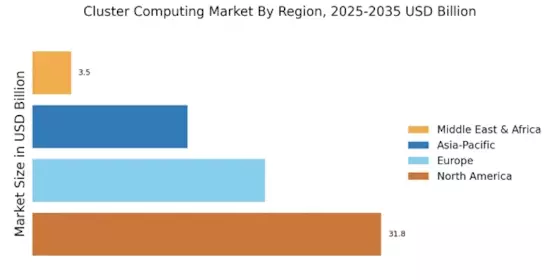Emergence of Edge Computing
The emergence of edge computing is reshaping the Cluster Computing Market. As more devices become interconnected, the need for processing data closer to the source is becoming paramount. Edge computing reduces latency and bandwidth usage, which is essential for applications such as IoT and real-time analytics. This shift is prompting organizations to adopt cluster computing architectures that can efficiently handle distributed data processing. The edge computing market is projected to grow significantly, potentially reaching 15 billion dollars by 2025. This growth will likely create new opportunities for the Cluster Computing Market as businesses seek to optimize their computing resources.
Growing Adoption of Big Data Analytics
The Cluster Computing Market is significantly influenced by the growing adoption of big data analytics. Organizations are increasingly leveraging cluster computing to manage and analyze large datasets, which is essential for deriving actionable insights. The ability to process and analyze data in real-time is becoming a critical factor for businesses aiming to maintain a competitive edge. Reports indicate that the big data analytics market is expected to reach a valuation of over 200 billion dollars by 2025, which will likely drive further investments in cluster computing solutions. This trend underscores the importance of scalable and efficient computing resources in the Cluster Computing Market.
Advancements in Networking Technologies
Advancements in networking technologies are playing a crucial role in the evolution of the Cluster Computing Market. Innovations such as 5G and high-speed fiber optics are enabling faster data transfer rates and improved connectivity among cluster nodes. This enhanced networking capability allows for more efficient data processing and resource sharing, which is vital for large-scale computing tasks. As organizations continue to adopt these advanced networking solutions, the demand for robust cluster computing systems is expected to rise. The integration of these technologies into the Cluster Computing Market may lead to more efficient and scalable computing environments.
Rising Need for Disaster Recovery Solutions
The rising need for disaster recovery solutions is becoming a significant driver in the Cluster Computing Market. Organizations are increasingly recognizing the importance of maintaining business continuity in the face of potential data loss or system failures. Cluster computing provides a reliable framework for implementing disaster recovery strategies, allowing for data redundancy and failover capabilities. As businesses invest in robust IT infrastructures, the demand for cluster computing solutions that support disaster recovery is likely to increase. This trend highlights the critical role of cluster computing in ensuring operational resilience within the Cluster Computing Market.
Increased Demand for High-Performance Computing
The Cluster Computing Market is experiencing a surge in demand for high-performance computing (HPC) solutions. Organizations across various sectors, including finance, healthcare, and scientific research, are increasingly relying on HPC to process vast amounts of data efficiently. This trend is driven by the need for faster data analysis and simulation capabilities. According to recent data, the HPC segment is projected to grow at a compound annual growth rate (CAGR) of over 7% through the next few years. As businesses seek to enhance their computational power, the Cluster Computing Market is likely to see a corresponding increase in investments in advanced cluster systems and technologies.


















Leave a Comment